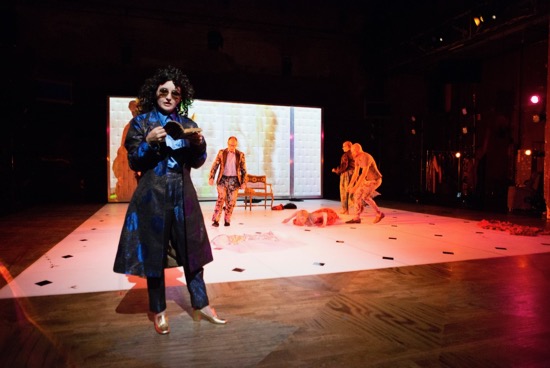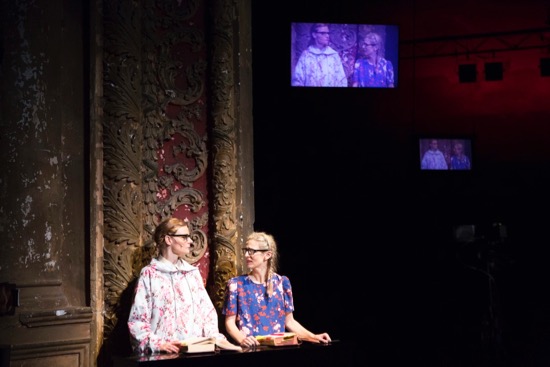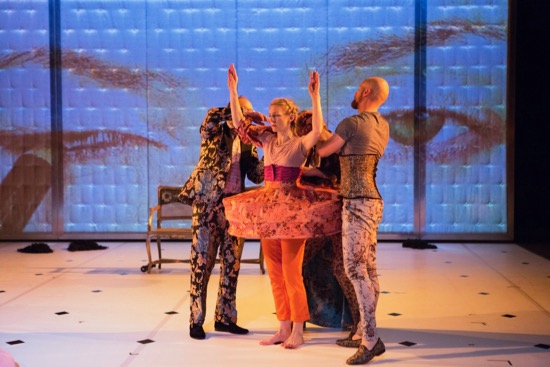Big Dance Theater premieres a new work at the BAM Harvey, November 14 through 18.

Big Dance Theater in 17c. L to R: Elizabeth DeMent, Cynthia Hopkins, Paul Lazar, Kourtney Rutherford, and Aaron Mattocks. Photo: Rebecca Greenfield.
I’d like to browse Annie-B Parson’s book shelves. What will she read to inspire the next dance theater piece that she choreographs for Big Dance Theater and, with Paul Lazar, directs? She slides together two or more disparate texts together and makes them strike sparks off each other. Maybe it’s not just her library I’d like to access, but her mind. As I gathered from a short, hilarious scene in BDT’s 25th anniversary season last year, she has been digging into the unexpurgated text of Samuel Pepys’ noted diaries (1660-1669) for some time. Now, at BAM Harvey, we get to see 17c, the culmination of her work on this subject, fueled too by sources such as playwright Eugene Ionesco and dance critic Jill Johnston.
Pepys’ diaries. Sigh. Was ever a man so intent on jotting down the trivia of his 17th-century days, as well as the political, social, and military maneuvers of the time? Of course, it is of interest now that he considered using “gray worms breathing in the wood” to soothe a toothache (did I hear that accurately?), but one marvels at the airing of his feelings and the details of his sex life. The natural juxtaposition is to Facebook and other social media sites, on which interesting information and thought are often overwhelmed by trivia (do we need to know about your new killer purple socks?). And Parson and Lazar go to town on certain aspects of Pepys’ confessional writings, ending his penned entries just before he blows out his candle and goes to bed.
The enormously gifted and beguiling performers—Elizabeth DeMent, Cynthia Hopkins, Aaron Mattocks, Kourtney Rutherford, and Lazar—frolic and reason in a flexible world. They also connive, get sick, and die. In the set designed by Joanne Howard, a very large padded white backdrop can be wheeled forward, angled, and folded on either end to appear smaller. Prominently projected on it: large eyes staring, closing, winking. Various chairs, lecterns, and platforms are also movable. Microphones are occasionally dropped on the floor to be picked up by another performer. Curly black wigs, Louis XIV style, appear on various people’s heads. A wheeled-on coat rack contains some of Oana Botez’s spectacular, ever-changing costume elements that turn the actor-dancers into confused-at-birth chameleons.

Big Dance Theater’s Cynthia Hopkins. At back (L to R): Paul Lazar, Elizabeth DeMent, Kourtney Rutherford, and Aaron Mattocks. Photo: Rebecca Greenfield.
Hopkins, be-wigged and sporting gold slippers, intermittently acts as a kind of emcee. She’s in front of us on the BAM Harvey stage before we know the piece has started. She has what purports to be an ancient, well-thumbed volume of Pepys’ diaries and introduces us to his memory-obsessed mind and his interest in his erect penis. In our first glimpse of all the performers, they’ve turned their backs to us and are staring at a projected image of us, seated and ready.
The quilted wall isn’t the only surface for projections. Two small screens are suspended high on either side of the stage, and they occasionally show white words on a candy-box pink background (video design: Jeff Larson; sound: Tei Blow). Early on, Mattocks and a blond-wigged, corseted DeMent dance at each other, without touching Their manners are courtly for the most part, but their conversations are centuries apart; Mattocks speaks in a thoroughly contemporary style, while DeMent is silent. Her refined 17th-century words are projected on the pink cards (in 17c, “alas!” frequently appears alone, to underscore what we’re seeing). Hopkins notes that two these are “dancing about their relationship”—that is, Pepys’ with his wife Elisabeth, or Bess. They had numerous servants but no children, although not for want of trying. She, it later turns out was fourteen years old when they wed and died of typhoid fever before reaching thirty. And she has no voice. If she kept a diary, did her husband burn it?

17c, by Annie-B Parson (conception, choreography, and, with Paul Lazar, direction). Kourtney Rutherford (L) and Elizabeth DeMent consider their texts. Photo: Rebecca Greenfield.
Several times, Rutherford and DeMent climb up to a high desk at one corner of the stage, don eyeglasses, and flip through large identical books, making identical gestures to illustrate the words they speak in unison (although they also address each other in more casual asides). They are surveying, annotating the Pepys texts, just as today fascinated others “annotate” Pepys’ diary entries on online sites.
Another writer figures in 17c: Margaret Cavendish, wife to a duke. Why is her name not better known? She was, alas, a woman (Pepys reviled her as mad). She produced philosophical texts, poetry, plays, writings on science, and more. How did she find the time? No children. Like the Pepyses. In her play, The Convent of Pleasure, there were to be no men, only independent, smart women. A male spy (a prince) infiltrates their society, disguised as a princess, with whom the play’s heroine is happy to romance, (although heterosexuality prevails). That’s why at the end of one of DeMent and Rutherford’s editorial sessions, the two fall into each other’s arms.

Big Dance Theater in 17c. Foreground in ruffled sleeves: Elizabeth DeMent. Observing (L to R): Aaron Mattocks, Kourtney Rutherford, Paul Lazar, and Cynthia Hopkins. Photo: Rebecca Greenfield.
Dancing also enters the plot as an element of intrigue and apparent infidelity. Crouching on the floor and all but whispering into a mic, Mattocks as Pepys mentions his wife’s lessons with a handsome dancing master. She enjoys the lessons so much, that she has asked for two a day. Hmm. Perhaps he should learn to dance too?
17c gallops along. From time to time, Hopkins, DeMent, or Rutherford say “skip ahead,” flipping the pages of the books they hold.
Amid the calculated dressing and undressing and rushing about, Lazar delivers a tightly focused monologue. He sits downstage center, spot-lit in an easy chair, with a warming fire projected on two of the screens, and channels Sam Pepys. As he speaks, he twists in his chair, sprawls, slides down, leans intently forward, as if what he’s saying is causing a monumental itch. His spoken diary entries don’t mention the Great Plague or the Great Fire of London; they’re all about his wife and her young companion/serving maid Deb.

A good wife’s reward? Elizabeth DeMent being dressed by (L to R): Paul Lazar, Kourtney Rutherford, and Aaron Mattocks. Photo: Rebecca Greenfield.
Lazar delivers the text in so skillfully nuanced a way that I yearn to get up and smack this Pepys fellow. He starts off by wondering whether his wife, glancing his way as she passed, noticed that he was not just chatting with Deb today, he had his hand in her “cunny.” Could Bess have seen that? Maybe not? He worries though, and over the course of many minutes, he replays what happened. Did anyone else spy on them? Oh that luscious Deb! He’ll have to fire her on some pretext. As the days of the 1660s roll by, he can’t resist trying to find her in her new place of employment and have a little fun. Lazar makes this comical but also appalling: the man’s deceptions, his anger (Deb bewitched him, not his fault).
This virtuosic solo begins to seem untowardly long, and I imagine that’s the point. Think of it in relation to those online sites, where people can maunder on and on, commenting, questioning, revisiting, rehashing. Pepys might have deplored its lack of privacy. Still, he must have expected his diaries to be read.
As he’s finishing, the remaining four members of the cast enter, each playing a guitar and singing. Their sweet harmonies evoke a butterfly—you know, those colorful fellows who flit from flower to flower and don’t live even as long as the blossoms do.
In the last part of 17c, various stage personnel take things away and move others around. Cleaning up. We see Mattocks and DeMent restless and sleepless on a platform, also viewed on a film shot from above. Lazar directs a sotto voce argument at Rutherford, who slumps over. A pillar of hedgery backed by a high platform serves as another forum for him, while on a chair to the side DeMent writhes, laughing wildly. This, we come to realize is Bess Pepys in the throes of her fever. Dying. Cutting her hair and tying pigeons to her toes are mentioned as possible cures, Joe Levasseur’s expert lighting changes colors radically, smoke appears.
This startling, vibrant puzzle of a piece is whirling in its own kind of delirium. Then suddenly the stage lights turn bright and workmanlike, and Rutherford in a pink tee shirt starts talking to us about the book. Which book? I’m too dizzy to write that fact down. Alas and alack. . . .
As with all the works by Parson that I’ve seen, 17c rocks my brain and my senses. The slippages of gender, love, power, truth, and lies both inhabit and transcend ideas and ways of life centuries apart. I want to read Margaret Cavendish’s play (to which her husband made some contributions!). I want to know—can never know—what young Elisabeth Pepys felt about her affectionate, philandering, infuriating husband and what joy her dancing lessons may have given her.

Great insights!!! Great work!! Thank you very much!